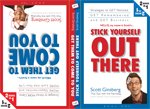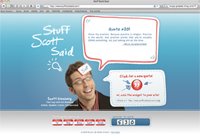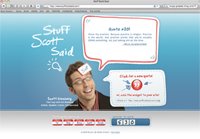 Bad news.
Bad news.
You are not impervious to the peril you advise others against.
If you’re a teacher, writer, speaker, coach, consultant, thought leader (even a parent), admitting that you need to take your own advice – and then, actually TAKING that advice – can be about as enjoyable as getting kicked in the face with a golf shoe.
THE POINT IS: We teach what we most need to learn.
And sometimes it’s tough to be true to your own insight.
If you’ve ever suffered from The Cobbler’s Children Syndrome, today we’re going to explore a series of practices for HOW to take your own advice:
1. Self-questioning. This is the best place to start. As a writer, speaker and thought leader myself, I’ve found great success (honestly) asking reflective questions like this on a regular basis:
a. If I were me, what would I do in this situation?
b. Does my life enshrine what my lips proclaim?
c. What does it look like when somebody pulls a “me”?
d. What key issue am I currently blinding myself from seeing?
e. Is the message I’m preaching the dominant reality of my life?
f. What outworn belief system is informing these bad decisions?
g. How deep is the gap between my onstage performance and backstage reality?
My suggestion is to pick a few from the list – or make your own list – then write the questions on sticky notes. Then post them in your office. Or bathroom. Or car. Anything to keep them in front of your face as reminders to take your own advice. What questions do you ask yourself?
2. Self-reeducation. Revisit material you’ve published but haven’t read in a while. Perhaps the distance away from your own content will help you to view it more objectively. For example, I’ve reread modules I wrote years ago that pleasantly surprised me of their relevance today. Almost like a reminder of what I believe about an issue.
Of course, I’ve also read old material that made me want to gag myself with a flyswatter. Which was an excellent education in my own evolution. Are you willing to disagree with what the earlier version of yourself believed?
3. Self-reflection. Sometimes you’re too close to yourself to see clearly. What you need is a friend to reflect your thinking style back to you. Try this: Find someone you’ve given valuable advice to in the past. Sit her down. Explain your situation.
Then ask her what advice she would expect YOU to give HER if the roles were reversed. Who knows? She might know a certain part of you better than you do. Who can you have lunch with that will function as a mirror?
4. Self-assessment. Try this exercise. At the top of a blank sheet of paper, write the following question, “If everybody did exactly what I said, what would the world look like?” Then, brainstorm your answers in the form of bullet points.
Take your time. Think hard. After all, you ARE writing your Personal Philosophy. Ultimately, the goal is to use this document as a template for future actions. Just remember to ask: Is what I’m doing right now giving people the tools they need to build that world?
5. Self-appointment. During your daily appointment with yourself, ritually revisit your values. Reread your Personal Mission Statement. Review your Personal Constitution. And explore your governing document for daily decision making.
By doing so each morning, it’s almost like giving yourself a pep talk. Reminding yourself who the heck you are, how you roll and what’s important to you. When was the last time you took fifteen minutes out of your day to just think?
6. Self-awareness. Physically ask people, “What is the best piece of advice I ever gave you?” Their answers might surprise you. You might be smarter (or dumber) than you think. You might also ask people if you can see their notes.
Or they’d be willing to email you their best keepers from your presentation. All helpful for increasing self-awareness. How do other people experience you?
7. Self-research. Google your name in quotes along with the word “says” or “said.” I just did this search on myself for the first time. Pretty interesting. Saw a few quotes I liked, a few quotes I forgot, along with a few quotes I’m embarrassed to ever have said.
But that’s not the point. What will REALLY blow your hair back is when you go one step further: Take all the past advice you’ve published and ask yourself how well you’re executing that advice in your own life. You may be surprised. Are your walkings consistent with your talkings?
REMEMBER: Staying true to your own insight takes a tremendous amount of self-reflection.
I challenge you to use these practices to help take your own advice.
And maybe The Cobbler’s kids won’t have to walk barefoot after all.
LET ME ASK YA THIS…
Are you smoking what you’re selling?
LET ME SUGGEST THIS…
For the list called, “23 Ways to Bring More of Yourself to Any Situation,” send an email to me, and you win the list for free!
Scott Ginsberg
That Guy with the Nametag
Author, Speaker, Coach, Entrepreneur
[email protected]
 Never the same speech twice.
Never the same speech twice.
Always about approachability.
Watch The Nametag Guy in action here!

 The world’s FIRST two-in-one, flip-flop book!
The world’s FIRST two-in-one, flip-flop book! People frequently ask me how I manage to be so productive.
People frequently ask me how I manage to be so productive. Who’s quoting YOU?
Who’s quoting YOU? There’s nothing more annoying than someone who has all the answers.
There’s nothing more annoying than someone who has all the answers. 
 1. Actions are antidotes. Mainly, to the fears you think are real. Which aren’t. Because they’re fears. And fears are only as real as your fear of them. Like the schoolyard bully whose sole source of power is your fear of him, most fears melt into a puddle of goo when you stand up to them.
1. Actions are antidotes. Mainly, to the fears you think are real. Which aren’t. Because they’re fears. And fears are only as real as your fear of them. Like the schoolyard bully whose sole source of power is your fear of him, most fears melt into a puddle of goo when you stand up to them.  1. Put your money where your foot is. Mouths don’t do anything but eat and talk. And occasionally drool. Feet, on the other hand, are profit centers. No wonder so many successful entrepreneurs have corns and calluses: It’s all about mileage.
1. Put your money where your foot is. Mouths don’t do anything but eat and talk. And occasionally drool. Feet, on the other hand, are profit centers. No wonder so many successful entrepreneurs have corns and calluses: It’s all about mileage.  PICTURE THIS: You just watched somebody give a speech.
PICTURE THIS: You just watched somebody give a speech.  Who’s quoting YOU?
Who’s quoting YOU? Sometimes we forget who we are.
Sometimes we forget who we are.